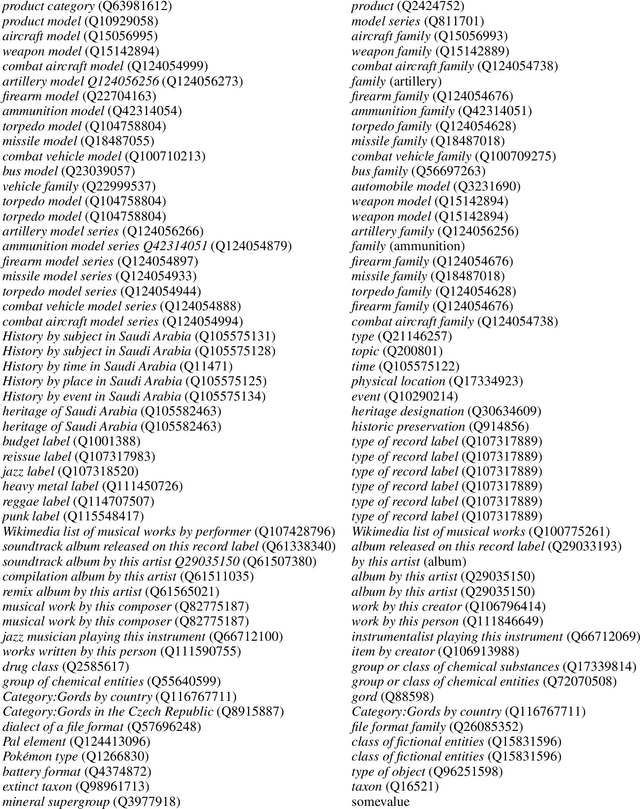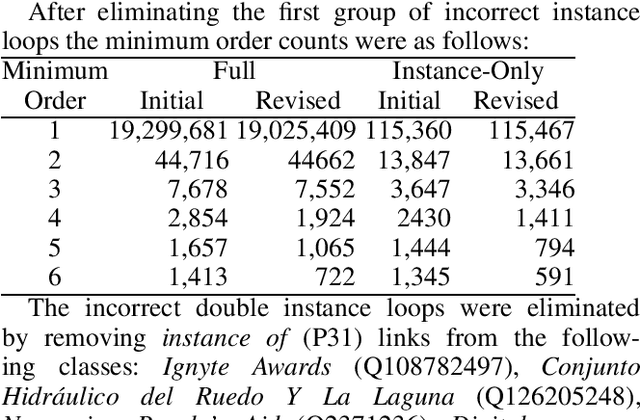Peter F. Patel-Schneider
Class Order Disorder in Wikidata and First Fixes
Nov 23, 2024

Abstract:Wikidata has a large ontology with classes at several orders. The Wikidata ontology has long been known to have violations of class order and information related to class order that appears suspect. SPARQL queries were evaluated against Wikidata to determine the prevalence of several kinds of violations and suspect information and the results analyzed. Some changes were manually made to Wikidata to remove some of these results and the queries rerun, showing the effect of the changes. Suggestions are provided on how the problems uncovered might be addressed, either though better tooling or involvement of the Wikidata community.
Disjointness Violations in Wikidata
Oct 17, 2024Abstract:Disjointness checks are among the most important constraint checks in a knowledge base and can be used to help detect and correct incorrect statements and internal contradictions. Wikidata is a very large, community-managed knowledge base. Because of both its size and construction, Wikidata contains many incorrect statements and internal contradictions. We analyze the current modeling of disjointness on Wikidata, identify patterns that cause these disjointness violations and categorize them. We use SPARQL queries to identify each ``culprit'' causing a disjointness violation and lay out formulas to identify and fix conflicting information. We finally discuss how disjointness information could be better modeled and expanded in Wikidata in the future.
Wikidata Constraints on MARS (Extended Technical Report)
Aug 17, 2020Abstract:Wikidata constraints, albeit useful, are represented and processed in an incomplete, ad hoc fashion. Constraint declarations do not fully express their meaning, and thus do not provide a precise, unambiguous basis for constraint specification, or a logical foundation for constraint-checking implementations. In prior work we have proposed a logical framework for Wikidata as a whole, based on multi-attributed relational structures (MARS) and related logical languages. In this paper we explain how constraints are handled in the proposed framework, and show that nearly all of Wikidata's existing property constraints can be completely characterized in it, in a natural and economical fashion. We also give characterizations for several proposed property constraints, and show that a variety of non-property constraints can be handled in the same framework.
Wikidata on MARS
Aug 14, 2020Abstract:Multi-attributed relational structures (MARSs) have been proposed as a formal data model for generalized property graphs, along with multi-attributed rule-based predicate logic (MARPL) as a useful rule-based logic in which to write inference rules over property graphs. Wikidata can be modelled in an extended MARS that adds the (imprecise) datatypes of Wikidata. The rules of inference for the Wikidata ontology can be modelled as a MARPL ontology, with extensions to handle the Wikidata datatypes and functions over these datatypes. Because many Wikidata qualifiers should participate in most inference rules in Wikidata a method of implicitly handling qualifier values on a per-qualifier basis is needed to make this modelling useful. The meaning of Wikidata is then the extended MARS that is the closure of running these rules on the Wikidata data model. Wikidata constraints can be modelled as multi-attributed predicate logic (MAPL) formulae, again extended with datatypes, that are evaluated over this extended MARS. The result models Wikidata in a way that fixes several of its major problems.
ASHACL: Alternative Shapes Constraint Language
Mar 09, 2017Abstract:ASHACL, a variant of the W3C Shapes Constraint Language, is designed to determine whether an RDF graph meets some conditions. These conditions are grouped into shapes, which validate whether particular RDF terms each meet the constraints of the shape. Shapes are themselves expressed as RDF triples in an RDF graph, called a shapes graph.
Using Description Logics for RDF Constraint Checking and Closed-World Recognition
Jan 21, 2015Abstract:RDF and Description Logics work in an open-world setting where absence of information is not information about absence. Nevertheless, Description Logic axioms can be interpreted in a closed-world setting and in this setting they can be used for both constraint checking and closed-world recognition against information sources. When the information sources are expressed in well-behaved RDF or RDFS (i.e., RDF graphs interpreted in the RDF or RDFS semantics) this constraint checking and closed-world recognition is simple to describe. Further this constraint checking can be implemented as SPARQL querying and thus effectively performed.
 Add to Chrome
Add to Chrome Add to Firefox
Add to Firefox Add to Edge
Add to Edge